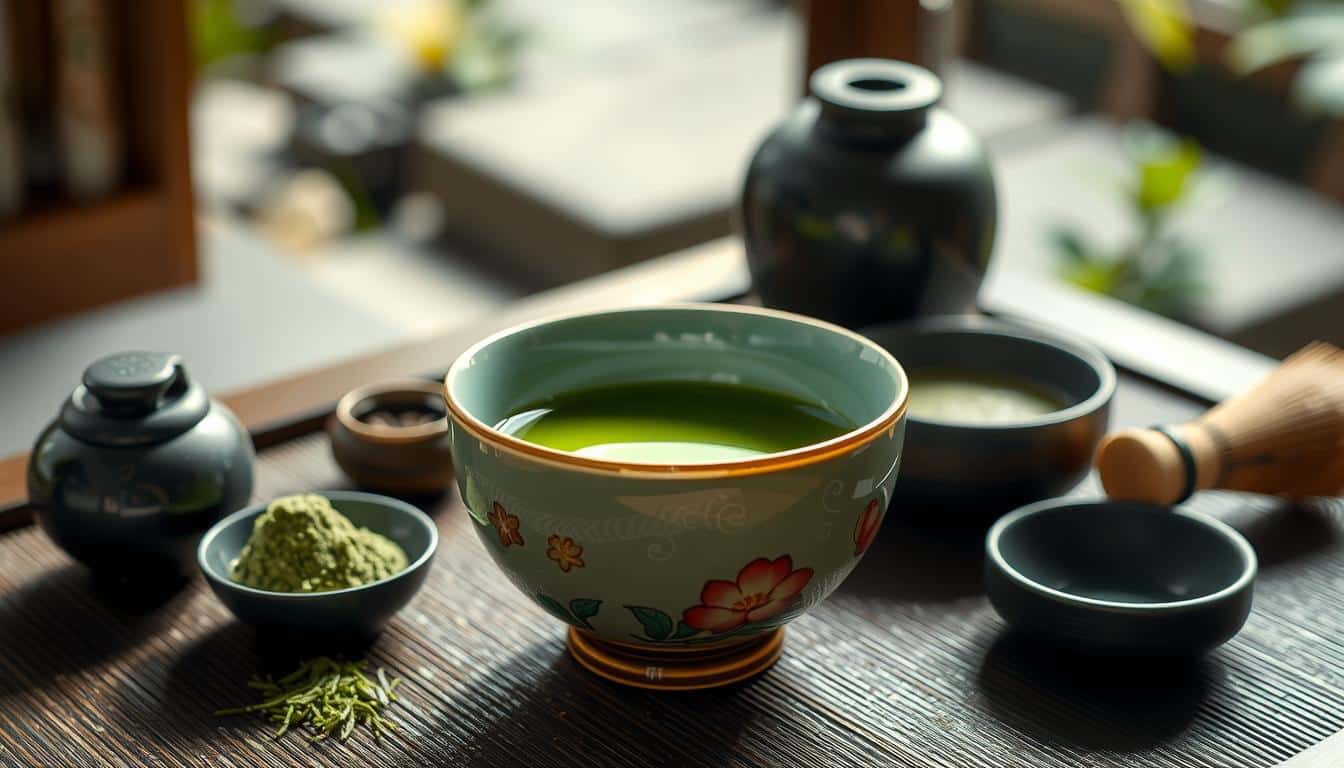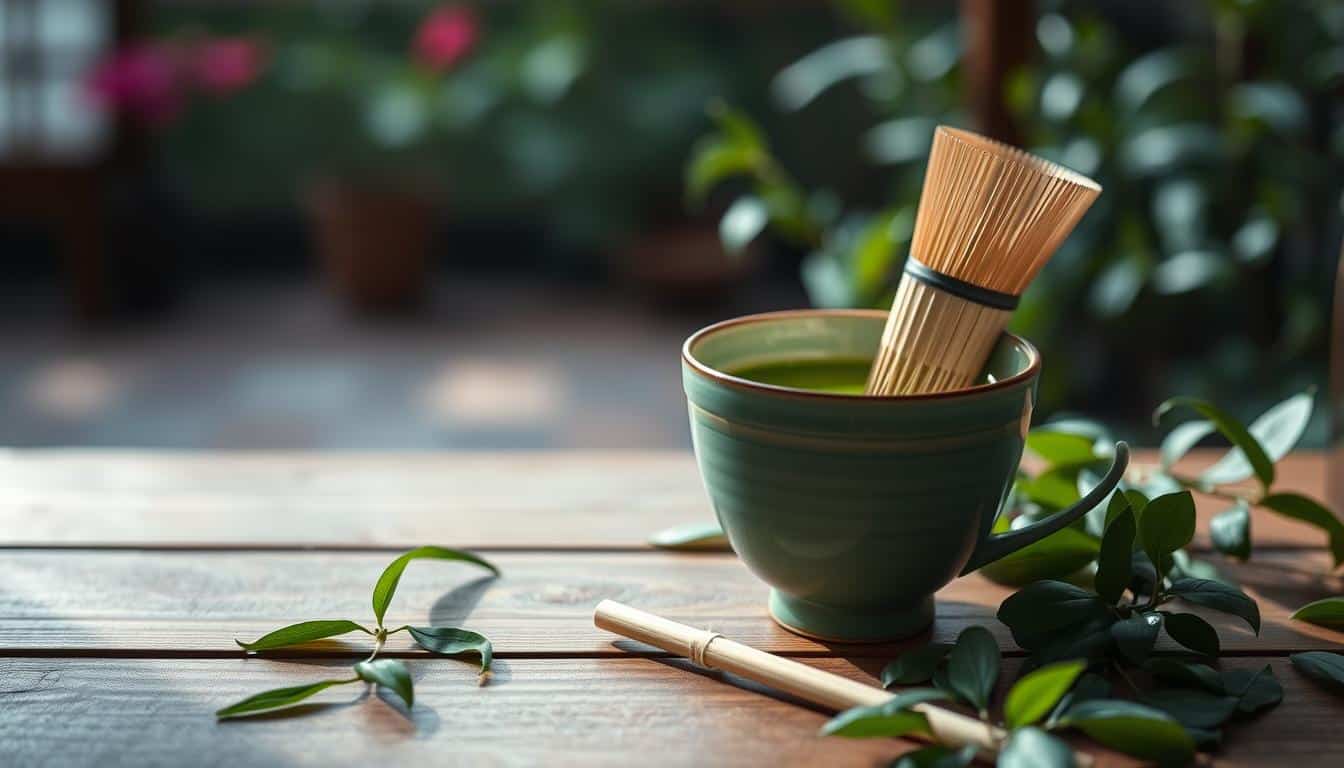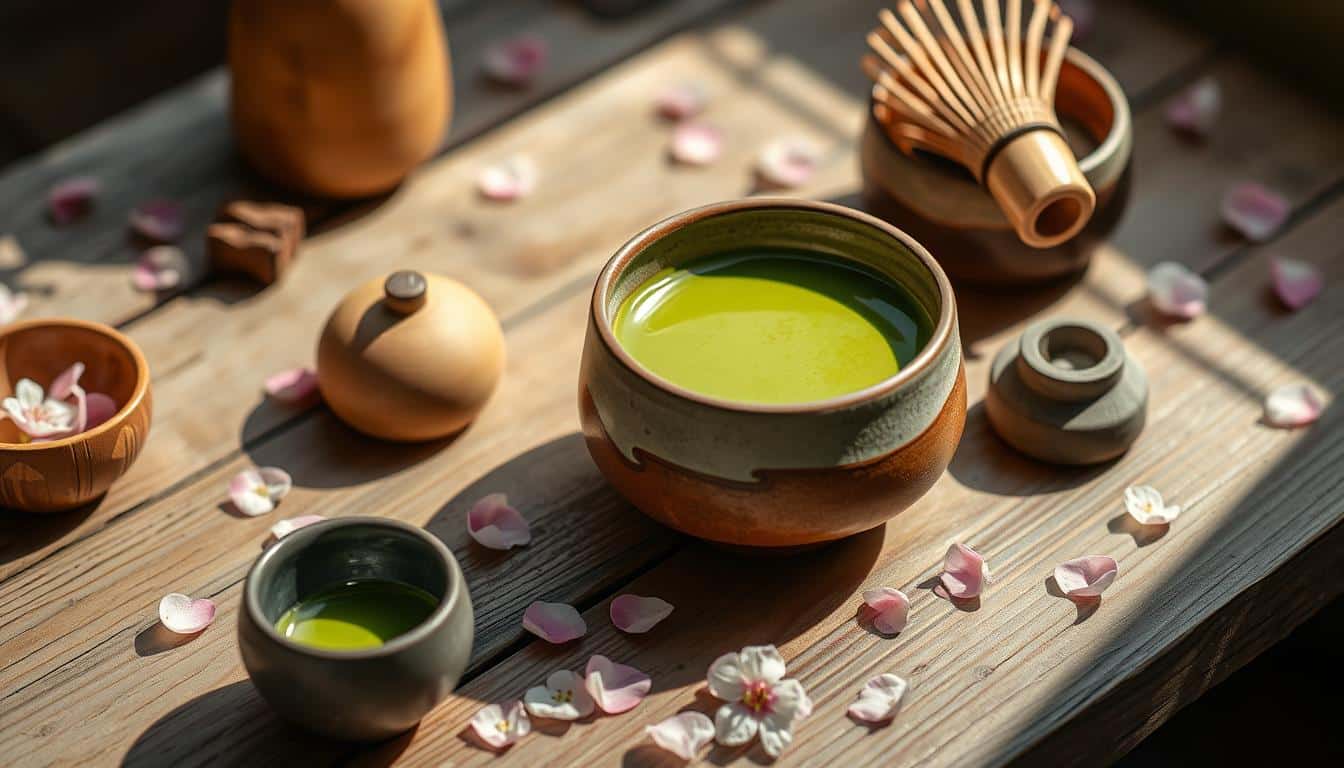Did you know traditional Japanese matcha bowls are made of heavy clay? They help you drink tea with two hands, making you focus on the moment. Finding the right matcha cup can make your daily tea a special ritual. It connects you with old traditions.
For matcha lovers like Jules Acree, the right Ritual Mug makes homemade matcha lattes an art. It lets you enjoy the rich taste and calming effects of ceremonial-grade matcha.
Matcha is getting more popular worldwide. So, finding the perfect matcha cup is key. The sold-out Ritual Mug is a great example of how a simple cup can change your daily tea routine. With its restock coming, now is the time to see how the right cup can make your morning tea a peaceful ritual.
Key Takeaways
- Matcha bowls come in various colors, patterns, and shapes to meet unique preferences.
- Traditional Japanese matcha bowls are usually made of clay, but ceramic options are also common.
- The shape of Japanese matcha bowls maximizes space for whisking motions.
- The heavy clay used in traditional matcha bowls encourages the use of two hands, enhancing presence.
- The handmade ceramic matcha bowl is discounted to $39.16 with an 11% membership discount on the original price of $44.00.
The Significance of the Matcha Cup in Japanese Tradition
The matcha bowl is key in Japanese tea ceremonies. It connects modern fans to old traditions. These ceremonies started in the 16th century and are full of history and culture. The design and making of traditional matcha bowls show the deep cultural value and care in the matcha ceremony.
The Role of the Matcha Cup in Tea Ceremonies
In a Japanese tea ceremony, every item, like the matcha bowl, is chosen with care. The bowl is often made of clay and needs both hands to hold. This shows the importance of being fully present when drinking tea.
The bowl’s shape helps in whisking and making the perfect froth for matcha tea. The designs on the bowl are not just for looks. They show respect and make the ceremony deeper.
Cultural Importance of Matcha Bowls
The matcha bowl is more than just a tool. It connects deeply with culture. These bowls have been used in traditional ceremonies since the 12th century, when monks brought tea from China to improve meditation.
Matcha tea and its ceremonies are so valued in Japan that they are seen as a “cultural treasure.” Today, the matcha bowl’s importance goes beyond Japan. It shows how much people around the world love matcha tea. Whether it’s a traditional set or a single bowl, these items keep the heritage alive and connect us to the past.
- Matcha bowls are mostly made of clay in Japanese tradition.
- Japanese matcha bowls have a cylindrical shape, unlike regular bowls.
- The patterns on traditional Japanese matcha tea bowls show respect during the ceremony.
- The heavy clay bowls need to be held with two hands, which makes you focus.
| Aspect | Significance |
|---|---|
| Material | Clay, showing tradition and realness |
| Shape | Cylindrical, helps in making tea |
| Pattern | Shows respect and cultural meaning |
| Usage | Held with both hands, encouraging mindfulness |
Types of Matcha Cups: Choosing the Right One for You
Matcha cups come in many styles, each designed to make your tea experience better. Whether you like the classic look of traditional bowls or modern designs, picking the right matcha cup is key. We’ll look at different types of matcha cups to help you find the best one for you.
Classic Ceramic Matcha Bowls
Classic ceramic matcha bowls, or Matcha-Chawans, are loved for their traditional look and craftsmanship. They give you a real matcha tea set experience with their classic designs. The Hira-Chawan is great for summer because it’s flat and thin, keeping your tea cool.
For winter, the Tsutsu-Chawan is better with its tall shape, keeping your tea warm. Beginners might like matcha bowls with a rounded base. These are easier to whisk and protect your bamboo whisk, or Chasen.
Also, Japanese matcha bowls often have patterns that show respect during the tea ceremony. These bowls are made from clay and need two hands to carry. This makes drinking tea a focused and mindful experience.
Modern Matcha Cups with a Twist
For those who like modern styles, contemporary matcha cups offer new designs while keeping the traditional matcha spirit. These cups often have features like heat insulation or ergonomic shapes. They fit well in a modern matcha tea set but still let you prepare matcha the traditional way.
It’s important to pick matcha cups that are not too rough or too slippery. These can make mixing the matcha powder with water hard and create bubbles. Finding the right texture is key for a good whisking experience. Modern matcha cups have also adapted to today’s tastes, offering ease and health benefits, as seen in this detailed article.
| Type | Characteristics | Best For |
|---|---|---|
| Hira-Chawan | Flat shape, thinner dish | Hot summer days |
| Tsutsu-Chawan | Cylindrical shape, thicker | Cold winter days |
| Modern Matcha Cups | Ergonomic, unique designs | Contemporary tastes |
By learning about the different types of matcha cups and their uses, you can choose the one that makes your matcha tea set and tea-drinking ritual better.
The Best Materials for Matcha Cups
Choosing the right material for your matcha cup is key to a great experience. Traditional pottery is a top choice for many, thanks to its deep history and craftsmanship. Japanese artisans make these bowls to bring out the best in ceremonial matcha. They think the pottery’s porosity changes the taste and feel of the tea.
Traditional Pottery
Traditional pottery cups are the top choice for matcha lovers. They honor Japan’s tea ceremony culture. Each bowl is handcrafted, showing the maker’s skill. The feel and warmth of traditional pottery make making and drinking ceremonial matcha special.
- Price Range: Traditional pottery cups cost from $80.00 to $275.00.
- Recommendations: The Shoraku Sasaki Kuroraku Chojiro Matcha Bowl is a top pick for its craftsmanship and costs more.
Modern Alternatives
Modern options blend style with function, offering a new take on matcha cups. You can find them in non-toxic, lead-free ceramics and glass. These materials add variety in look and feel, making them great for daily use or modern settings.
- Types: Choices include the Glass Simple Mug at $12.00 and the Matcha Pouring Bowl at $30.00.
- Care: Many modern options are dishwasher safe, making them simple to clean and keep up.
| Material | Price Range | Unique Features |
|---|---|---|
| Traditional Pottery | $80.00 – $275.00 | Handcrafted, porous enhancing flavor |
| Modern Ceramics | $12.00 – $30.00 | Non-toxic, easy to clean |
| Glass | $12.00 – $30.00 | Modern aesthetic, functional |
Whether you like the history of traditional pottery or the new look of modern options, the material of your matcha cup matters. Each type has its own benefits that can make your matcha better, whether for ceremonies or everyday drinking.
How to Care for Your Matcha Cup
Keeping your matcha cup clean is key to making it last longer and keeping your traditional matcha tasting great. Clean your matcha cup right to keep it looking good and working well. This is true whether it’s a new cup or an old pottery piece.
Cleaning and Maintenance Tips
To clean your matcha cup, use soft cleaners and gentle materials. Don’t use strong cleaners as they can harm the cup. Clean it with mild soap and warm water instead. Always rinse your cup well and dry it with a soft cloth to stop residue from building up.
For a traditional matcha setup, take care of all your tools. Soak the bamboo matcha whisk before using it and dry it well after. Keep the chasen on a holder to keep it in good shape. This way, your matcha whisk can last about 12-18 months.
Preserving the Longevity of Your Cup
How long your matcha cup lasts depends on how you take care of it. Traditional pottery and lead-free ceramics need special handling. Don’t change the temperature suddenly to avoid cracks. Always keep your matcha cup in a dry spot to stop moisture damage.
If you drink matcha two to three times a day, keep your tools sharp. Use a special matcha bowl, not a coffee mug, to protect your whisk. Bamboo chasen have about 100 prongs, and damage can mess up the froth.
Follow these steps to keep your matcha cup and tools for your tea rituals. Here are the main care tips:
- Use mild soap and warm water for cleaning.
- Avoid harsh detergents and abrasive materials.
- Dry thoroughly after each use.
- Store in a dry place to prevent moisture damage.
- Maintain your matcha whisk by drying and storing on a holder.
By following these tips, you’ll always have the perfect traditional matcha.
Enhancing Your Matcha Ritual with the Perfect Cup
Choosing the right matcha bowl can make your matcha ritual better. It changes how you see and feel the experience from start to finish.
Matcha has a long history in Japan, thanks to a monk named Eisai in the 12th century. He brought back finely-ground tea leaves. Now, making matcha is easier and loved for its careful steps.
Handling a well-made matcha bowl makes you more mindful. It’s key for enjoying the matcha ritual. The bowl should match the green color of the matcha, making it more beautiful and mindful.
For the best matcha, use water at 175°F. Fresh, filtered water makes it taste purer. Or, mix it with warm milk for a tasty latte.
High-quality matcha is key for a great tea. It tastes better and is full of antioxidants. This tea gives you calm energy, making it good for your daily life.
- Historical Context: A Buddhist monk found finely-ground tea leaves in the 16th century, leading to matcha.
- Flavor Profile: Matcha is known for its grassy, savory taste with nutty notes.
- Health Benefits: Matcha is full of antioxidants, boosting health with every sip.
- Quality Control: Good matcha comes from trusted Japanese brands, tested for safety and quality.
Matcha is packed with antioxidants and tastes earthy to slightly nutty. Whisking it well makes a frothy top, just like in traditional ceremonies.
Whether it’s a big ceremony or a quiet moment, the right matcha cup makes the ritual special. It turns daily practice into a cherished matcha experience.
Ceremonial vs. Everyday Matcha Cups: What’s the Difference?
When you start with matcha, knowing the difference between ceremonial matcha cups and everyday matcha cups is key. Each type has its own purpose. They match the unique way you enjoy matcha, whether it’s for a special ritual or just to get a boost.
Understanding Ceremonial Matcha Cups
A ceremonial matcha cup is more than just a cup. It’s a symbol of Japan’s tea ceremony traditions. These cups are made with care and have beautiful designs. They’re used for the best matcha, made from young tea leaves and buds.
This matcha is made by stone milling for hours. It makes a fine powder that tastes delicate yet rich. Because of the effort put into it, ceremonial matcha is more expensive. But it’s worth it for the beautiful experience it offers.
These cups make the matcha look and taste amazing. They create a deep green, frothy drink that’s smooth and flavorful. The leaves are cleaned well, making the tea taste refined, calm, and energizing.

Choosing an Everyday Matcha Cup
An everyday matcha cup is for everyday use. It’s practical and easy to use. These cups are part of a matcha tea set and are made for daily enjoyment. They’re a good mix of being useful and affordable.
They might not be as fancy as ceremonial cups, but everyday matcha cups are great for everyday use. They’re good for making matcha drinks, smoothies, or adding to recipes. This matcha is a bit cheaper and tastes slightly bitter. It’s full of antioxidants and catechins, making it a strong choice for many recipes.
Knowing these differences helps you pick the right matcha cup for you. This way, every time you drink matcha, it’s just what you wanted.
The Importance of Matcha Utensils for the Perfect Brew
Brewing the perfect cup of traditional matcha is more than just about the tea leaves. It’s about using special utensils that make the experience better. The matcha whisk and scoop are key tools.
The Matcha Whisk (Chasen)
A traditional Japanese matcha whisk, or chasen, is made from one piece of bamboo. It has many prongs to help mix the matcha into a smooth froth. Making a chasen takes eight steps, checked by a master craftsman.
Chasens with 68-120 strings are best for a frothy drink. But, if you don’t have one, you can use a milk frother or blender as a substitute.
The Matcha Scoop (Chashaku)
The matcha scoop, or chashaku, is also made from bamboo. It’s used to measure the right amount of matcha powder. About 2 grams is perfect for a balanced taste.
These utensils are key for making matcha and show the care in the traditional ritual. Using a chasen and chashaku makes your tea preparation more authentic and enjoyable.
For more on matcha utensils and brewing tips, check out this guide on matcha tea bags.
How the Right Matcha Cup Can Enhance Flavor
The matcha cup you use can change how you taste the matcha. A traditional matcha bowl is wider, which helps mix the tea well. This makes the tea’s earthy and nutty flavors come out more.
The material of the cup is also important. It can keep the tea hot or cool it down fast. This changes how the tea tastes.
Using a ceramic matcha cup keeps the tea at the perfect temperature. This makes the tea smoother and less bitter. For beginners, use 1 teaspoon of matcha for every 8 ounces of water. If you like it milder, use 1/2 teaspoon. For a stronger taste, use 2 teaspoons.
Choosing the right cup helps keep the matcha’s texture and color bright green. For more tips, check out here.

Decaf matcha is also powerful. It has the same good stuff as regular matcha but less caffeine. You can read more about it here. Whether you like matcha lattes or traditional usucha, these tips will make your matcha better.
Personalizing Your Matcha Experience with Unique Cups
Starting a custom matcha experience lets you add your style to every sip. Choosing artisan matcha cups made by skilled craftsmen adds a special touch to your tea time. These hand-crafted pieces are not just useful. They also show off your unique style, making each matcha bowl a celebration of you.
Artisan-Made Matcha Cups
Artisan matcha cups are truly a work of art. Skilled artisans make them with a unique flair. They respect the tradition of matcha while adding modern artistic touches. You can find cups with intricate gold and silver designs or sakura themes. These options make your matcha experience both beautiful and rich.
Glassware matcha bowls are getting more popular because they’re versatile and elegant. They stay cool even when the tea is hot, making your experience more enjoyable. The designs on these bowls are a feast for the eyes, with gold and silver adding a touch of luxury.
Customizing Your Matcha Bowl
Personalizing your matcha bowl helps you connect more with your tea ritual. You can choose specific designs or work with a local ceramicist to create your own. This way, your matcha bowl reflects your personal taste and style. Whether it’s a golden, silver, or celestial-themed bowl, it makes your tea time special.
Custom matcha experiences show off your individuality. By picking or designing a bowl that speaks to you, your tea rituals become a personal ceremony. Think about getting high-quality matcha from brands like Ippodo Tea, Kettl, or Matchaful to improve your tea-drinking experience.
Conclusion
The matcha cup is more than just a simple cup. It has deep roots in Japanese tradition, dating back to the 8th century. It’s a key part of the matcha ritual, making the experience richer.
Glazes were first used in the Heian period. Tea masters like Sen-no-Rikyu in the 16th century refined and made it more artistic. Each matcha bowl has its own story.
There are many types of matcha cups, like Raku and Shino wares. Modern ones from DōMatcha® in Deep Ocean, Red Soul, and Branded Black add a touch of elegance. The right cup can make your matcha ritual special.
You can pick a traditional ceramic bowl, an Oribe-ware piece, or a hand-painted Kutani bowl. Each one not only improves the taste but also shows your style. It shows your dedication to this ancient practice.
Looking after your matcha cup is important to keep it lasting long. You should wash it gently and handle it with care. This keeps it beautiful and useful.
Buying a matcha cup is a choice for mindfulness and a special matcha experience. It connects you to an ancient tradition that fits today’s life. This choice can make your life richer.


